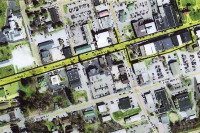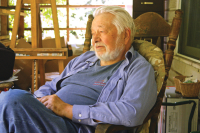The Naturalist's Corner
Bats make good just in time to salvage outing
“Oh lord, please don’t let me be misunderstood.”
That refrain from the old Animals song runs through my head every time I think about bats. Or I see images of women, running, screaming with arms flailing all around their heads to keep the bats out of their hair. Or perhaps Bela Lugosi standing with a cape drawn across his mouth to hide his fangs, mumbling something like, “I vant to bite your neck.”
But the other evening, the only thought that kept going through my mind was, “Where are the bats?” My 7-year-old’s lips were trembling and tears were welling up in her eyes.
“Daddy you promised we would see bats,” she said, sniffling.
“No, baby,” I said, “somebody told me this was a good place to see bats, and I said we would go look for bats.”
Related Items
We had watched the sun fall into the Little Tennessee River. Cave swallows had returned to their round jug-like nests under the bridge to roost (another new site for this species in the mountains). The sky was growing darker and darker but still no bats. We reluctantly climbed back into the car to leave, but I didn’t have the keys. I opened the door and got out to retrieve the keys from under the seat.
Hmmm, what was that? “I thought I saw a high-flying bat along that ridgeline over there,” I said. “Look there’s another one way up there.”
“Daddy! One just flew over the car!” Izzy shouted.
Everyone scrambled back out of the car. The bats were there! There weren’t a million, living under the Congress Avenue Bridge in Austin, Texas. But there were dozens flying around. My wife involuntarily flinched when a big brown glided out of the darkness and swooshed past.
We had taken a small bag of feed corn with us to lure the bats closer. No, bats don’t eat corn. But you toss it up in the air and the bats hone in on it with their echolocation and come in for a closer look. You can also use gravel or small rocks. However, the swarms of insects along the road shoulder kept the bats fluttering by nearly at arm’s length.
Insectivorous bats’ echolocation is so sophisticated that they can tell the size of the insect and what direction it is moving. And different species of bats have evolved to hunt in different niches. The bats that were down at the roadside with us were most likely little browns and big browns, you could discern a little size difference. Little browns have an average wingspan of around 10 inches and big browns’ wingspan is about 13 inches.
Like the accipiters of the bird world, little brown, big brown and other bats that hunt insects low, in the canopy and around bushes, have short, broad wings that provide more lift and maneuverability. Bats like the hoary bat that cruises above the canopy have longer narrower wings (like the falcons of the bird world) and are swifter, stronger flyers. A hoary may cover nearly 25 miles in an evening as it searches for food. These high, fast flying bats also echolocate on a lower frequency. Lower frequencies carry farther, and it allows these fast flyers to detect prey at greater distances.
Bats may be observed at dusk almost anyplace there is an open area. We always have a few cruising our yard in the evening. If you add water — a lake or river — it increases the likelihood of viewing bats.









